Gourami is a captivating freshwater fish originating from Asia. They have a special feature, a labyrinth organ, that allows them to breathe air – a unique trait that helps them adapt to different water conditions. With their striking colours and diverse species, they offer an exciting range in appearance and size.
They’re generally peaceful, making them a great addition to home aquariums. Taking care of them is straightforward with the right tank setup and diet. For those interested in breeding, Gourami’s can comfortably do so in captivity. For anyone passionate about aquatics, Gourami’s are a brilliant choice.
Table of Contents
Gouramis: Why Should You Get This Fish For Your Aquarium?
When it comes to choosing the perfect fish for your aquarium, there’s a lot to consider. You’re likely looking for a species that’s hardy, attractive, peaceful, and easy to care for. Well, Gourami’s tick all these boxes and more.
- Adaptable: Their unique labyrinth organ allows them to breathe air, which means they’re able to adapt to various water conditions.
- Aesthetically Pleasing: With their vibrant colours and diverse range of species, Gourami’s can add a pop of colour and visual interest to any aquarium.
- Peaceful Nature: Gourami’s are generally peaceful and get along with a variety of other species, which makes them a safe addition to your community tank.
- Straightforward Care: Gourami’s aren’t overly demanding when it comes to their care. With the right tank conditions and diet, they can thrive, making them suitable for both beginners and seasoned aquarists.
- Breeding Opportunity: An interesting feature of Gourami’s is their ability to breed in captivity. This provides an intriguing opportunity to observe and learn more about their lifecycle, adding another layer of enjoyment to the aquarium hobby.

Gourami Facts & Overview
Origin & Distribution
Gourami’s, also known as “Anabantoids,” are originally from Asia, with a vast majority found in South and Southeast Asia. Their habitats range from slow-moving or stagnant bodies of water, such as marshes, ponds, and lakes, to fast-flowing streams and rivers. They’re found in countries like India, Pakistan, Malaysia, Korea, and Indonesia, among others.
Some species of Gourami’s have also been introduced to non-native regions, including the U.S. and Colombia, often due to the aquarium trade. These adaptable fish have thrived in different environments across the globe, making them a truly international species. It’s important to note, however, that some species have become invasive in areas outside their native range, disrupting local ecosystems.
Species Overview and Subtypes
Gourami’s are a diverse group of freshwater fish that belong to the family Osphronemidae. They’re known for their vibrant colours, patterns, and range in size, making them a popular choice among aquarists. Here’s a snapshot of some of the species:
Dwarf Gourami: Small and vibrantly coloured, they are a favourite among hobbyists. There are several colour variants within the Dwarf Gourami, such as the Powder Blue Dwarf Gourami and Flame Dwarf Gourami.
- Blue Gourami or Three-spot Gourami: These fish are known for their attractive blue colour and two dark spots on their bodies (the third spot is the fish’s eye).
- Pearl Gourami: Recognizable by the ‘pearl’ spots on their bodies, they’re peaceful fish and a great addition to a community tank.
- Moonlight Gourami: These fish have a distinct, slender body with a silver sheen, resembling the glow of moonlight.
- Kissing Gourami: Named for their ‘kissing’ behaviour, which is actually a form of aggression or competition.
- Giant Gourami: The largest species of Gourami’s that are usually kept in ponds due to their potential size.
- Honey Gourami: They are small, peaceful, and have a warm honey-coloured hue that intensifies during the breeding period or when they feel territorial.
- Snakeskin Gourami: Known for their unique, snakeskin-like pattern, these fish are larger and have a more elongated body compared to other gourami’s.
Each Gourami species has its own unique needs and behaviours, but generally, they are considered a rewarding fish to keep due to their interactive nature and striking appearance.

Gourami Lifespan
The lifespan of Gourami’s varies based on their species, diet, and the care they receive. On average, most species of Gouramis live between 4 to 6 years in a well-maintained aquarium. However, under optimal conditions, some Gourami’s, like the Blue or Three-spot Gourami, can live up to 10 years or more.
Factors contributing to a longer lifespan include a balanced diet, appropriate tank mates to minimize stress, regular water changes, and an environment that simulates their natural habitat. Keep in mind that Gourami’s are susceptible to various diseases if their environment is not properly managed, which can significantly reduce their lifespan. Good aquarium practices are key to ensuring your Gourami’s lead a long, healthy life.
What Do They Look Like?
Gourami’s are known for their striking colours, diverse patterns, and variety of sizes, which contribute to their popularity in the aquarium trade. Here’s a general overview of their appearance:
- Body Shape: Typically have a compressed, oval-shaped body with a distinct dorsal fin that runs the length of the body, ending in a point near the tail.
- Colours and Patterns: Their colours and patterns greatly vary among species. They can be solid, like the Blue Gourami, patterned like the Pearl Gourami, or vibrant and multi-colored like the Dwarf Gourami.
- Size: Gourami’s range widely in size. The Dwarf Gourami, for example, grows up to 2-3 inches, while the Giant Gourami can reach an impressive 28 inches when kept in optimal conditions.
- Labyrinth Organ: All Gourami’s have a unique labyrinth organ behind their heads, which acts like a lung and allows them to breathe air directly. This is often not visible but is a key identifying feature.
- Mouth Structure: Gourami’s have a small, upturned mouth with thick lips. Some species like the Kissing Gourami are recognized for their protruding lips that resemble a ‘kissing’ motion.
- Feelers: Many Gourami’s have thread-like extensions or ‘feelers’ that they use to sense their surroundings. These are particularly noticeable in species like the Dwarf Gourami.

Understanding Gouramis
Air Breathers
Gourami’s are known as air-breathing fish due to their unique labyrinth organ. This is a special structure located in their head, which acts like a lung, allowing Gourami’s to breathe air directly from the surface. It’s a feature they share with a few other fish species, like Bettas and Paradise fish.
The labyrinth organ is particularly beneficial in their native habitats in Asia, which often include stagnant or slow-moving bodies of water where oxygen levels can be low. The fish can gulp air at the surface, and the oxygen is absorbed in the labyrinth organ.
This trait also allows them to survive in less than optimal water conditions, but it doesn’t mean they should be kept in such environments. They still need clean, well-filtered water to stay healthy and stress-free. This ability to breathe air also means you’ll often see Gourami’s coming to the water surface to take a gulp of air, which is a completely normal behaviour.
Natural Habitat for the Gourami
Gourami’s originate from a wide range of habitats across South and Southeast Asia. They are typically found in freshwater bodies, including slow-moving or stagnant water bodies such as marshes, swamps, ponds, and lakes, as well as faster-flowing streams and rivers. These environments often feature warm, slightly acidic to neutral water, and are densely vegetated, providing Gouramis with plenty of hiding spots.
Countries like India, Pakistan, Malaysia, Korea, and Indonesia, among others, host various species of Gourami’s. The specific habitat conditions can vary depending on the Gourami species. For instance, some species like the Dwarf Gourami are typically found in slow-moving or stagnant water with plenty of vegetation, while others like the Giant Gourami are often found in larger, open water bodies.
When setting up an aquarium for Gouramis, it’s recommended to replicate these natural conditions as closely as possible, with plenty of plants for hiding and ample swimming space. Water conditions should be kept stable with regular monitoring and maintenance.
Gourami’s Behaviour/Compatibility & Temperament
Gourami’s are generally peaceful and sociable, making them suitable for community tanks. However, they can exhibit territorial behaviour, especially during breeding or in crowded conditions. Larger species may bully smaller ones, so it’s crucial to select tank mates wisely.
Ideal companions include similarly sized, non-aggressive species. Despite their mostly peaceful demeanour, male Gourami’s can be aggressive towards each other, so a balanced male-to-female ratio is recommended. Gourami’s are also known for their curious nature and often interact with their environment, making them a delightful addition to any aquarium.
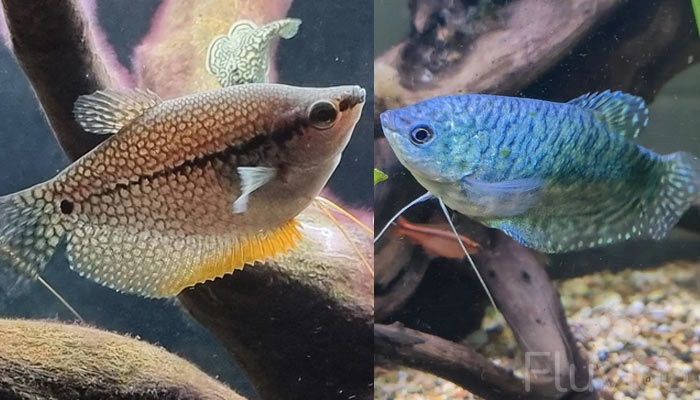
Male vs Female Gouramis
Differentiating between male and female Gourami’s can be challenging for some species, but there are a few general characteristics to look out for:
- Colour: Male Gourami’s usually have brighter colours compared to females. This is particularly noticeable in species like Dwarf Gourami’s.
- Dorsal Fin: Males typically have a more pointed dorsal fin, whereas females often have a rounded or curved dorsal fin.
- Body Shape: Females generally have a more rounded body shape, especially noticeable when they’re carrying eggs. Males, on the other hand, are often more streamlined.
- Size: In many Gourami species, males are slightly larger than females, although this isn’t always a reliable factor as it can vary based on individual growth rates.
- Behaviour: Males tend to be more territorial and may display more aggressive behaviour compared to females, especially during the breeding period.
Gourami Tank Setup
Aquarium setup
The housing requirements and tank size for Gourami’s can greatly vary based on their species due to the wide range of their sizes. Here are general guidelines:
- Tank Size: As a rule of thumb, smaller Gourami’s like the Dwarf Gourami require a minimum tank size of 10 gallons, but a 20-gallon tank is preferred for them to thrive. Larger species, like the Blue or Three-spot Gourami, should have at least a 35-55 gallon tank due to their size and activity levels. The Giant Gourami, the largest species, will require a much larger space, such as a pond or a tank of several hundred gallons.
- Water Parameters: Gourami’s typically prefer slightly acidic to neutral pH levels (around 6.0-7.5), although they are quite adaptable. Water hardness should be kept in the range of 5-20 dGH.
- Temperature: Ideal water temperature for Gourami’s is usually between 72°F and 82°F (22°C-28°C), depending on the species.
- Tank Setup: Gourami’s appreciate tanks with plenty of plants and hiding spots, as they mimic their natural habitats. However, leave some open swimming space as well. A lid is recommended as some species can jump, and it can also help maintain humidity for their labyrinth organ.
- Filtration: A good filtration system is important for maintaining water quality. However, Gourami’s prefer calm water, so avoid powerful filters that create strong currents.
Always research the specific requirements of the Gourami species you wish to keep to ensure the appropriate environment for them to thrive.
Decoration
Decorating your Gourami tank is not just about aesthetics, it also contributes to the well-being of your fish by mimicking their natural environment. Here’s what you might consider:
- Live Plants: Gourami’s come from areas rich in vegetation. Plants like Java fern, Anubias, and Amazon swords are great as they are sturdy and can withstand Gouramis’ interaction. Floating plants can also provide shading and cover, which Gourami’s appreciate.
- Hiding Spots: Gourami’s enjoy places to hide and rest. This can be provided with caves, driftwood, and densely planted areas. Make sure there are enough hiding spots for each fish to minimize territorial disputes.
- Substrate: A dark substrate can help bring out the colours of your Gourami’s. It can be either gravel or sand, depending on the other inhabitants’ needs and your aesthetic preference.
- Lighting: Gourami’s don’t require special lighting. Moderate lighting is sufficient, which can also support live plant growth.
- Space: While decorations are important, ensure there is enough open space for swimming. Overcrowding the tank with decorations can stress the fish.
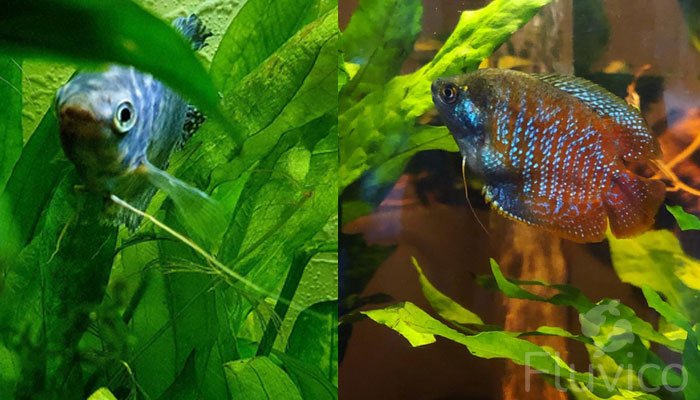
Gourami Care
Diet
Gourami’s are omnivorous and have a diverse diet that includes both plant and animal matter, making feeding them relatively easy. Here’s a general overview of their dietary needs:
- Flake and Pellet Food: High-quality flake or pellet food can serve as the base of the Gourami diet. These foods are nutritionally balanced and come in different formulas to meet the needs of different fish.
- Live and Frozen Foods: Supplementing the diet with live or frozen foods such as brine shrimp, bloodworms, or daphnia can add variety and help keep your Gourami’s healthy.
- Vegetables: Gourami’s also enjoy the occasional vegetable in their diet. Blanched vegetables like spinach, peas, zucchini, and cucumber can be a great treat.
- Feeding Schedule: It’s recommended to feed Gourami’s once or twice a day, only as much as they can consume in a few minutes. Overfeeding can lead to health issues and dirty the tank water quickly.
Remember, dietary needs can vary slightly depending on the species of Gourami, so it’s always a good idea to research the specific dietary requirements of the particular Gourami species you have.
Tank Mates
When selecting tank mates for Gourami’s, it’s crucial to keep their behaviour, size, and water conditions in mind. Gourami’s are generally peaceful, but they can become territorial, especially males during breeding times.
Here are some ideal tank mates for Gourami’s:
- Other Gourami’s: Multiple Gourami’s can live together in a tank, but it’s essential to maintain a proper male-to-female ratio to reduce aggression. Also, ensure that the tank is large enough to prevent territorial disputes.
- Tetras: Many tetra species like Neon Tetras, Cardinal Tetras, or Rummy-nose Tetras can be great tank mates due to their peaceful nature and similar water requirements.
- Rasboras: Rasboras are peaceful schooling fish that can coexist well with Gourami’s.
- Corydoras Catfish: Corydoras are peaceful bottom dwellers that won’t compete with Gourami’s for space.
- Loaches: Certain loach species like the Kuhli Loach can be a good choice as they are peaceful and inhabit different areas of the tank.
- Livebearers: Fish like Guppies, Mollies, Platies, and Swordtails can also be good companions, given they have similar water and temperature requirements.
Avoid pairing Gourami’s with aggressive or much larger fish that may bully or eat them. Similarly, tiny, slow-moving fish might be stressed by larger, more active Gouramis. Always monitor the tank to ensure all inhabitants are getting along well and ensure the tank is spacious enough to accommodate all the fish comfortably.
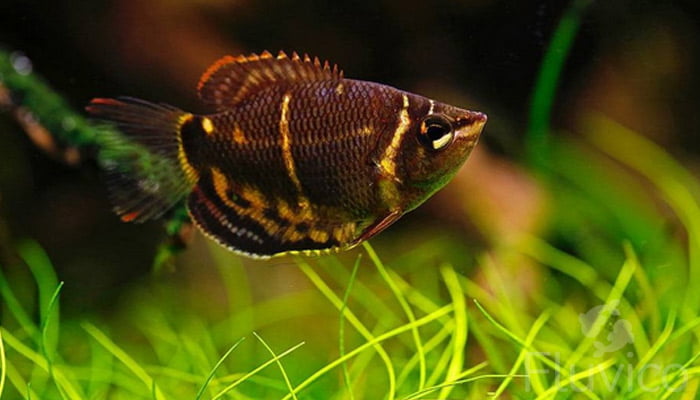
Disease
Gourami’s, like any other fish, can be susceptible to various diseases, especially when kept in less-than-optimal conditions. Here are a few common diseases that Gourami’s can contract:
- Ich (White Spot Disease): This is a common freshwater fish disease caused by a parasite. Fish with Ich will have tiny white spots on their bodies and may rub against tank décor. Increasing the water temperature slightly and using over-the-counter treatments can help fight the disease.
- Fin Rot: This is a bacterial infection that results in fraying or disintegration of fins. It’s often caused by poor water conditions or injury. It can be treated with water changes, improved water conditions, and specific medication if necessary.
- Dropsy: This disease causes fish to bloat and scales to protrude. It’s usually a symptom of a bacterial infection and can be challenging to treat. Early detection and antibiotic treatment give the best chance of recovery.
- Swim Bladder Disease: This causes abnormal swimming, like floating upside-down or sideways. It can result from overfeeding, constipation, or injury. Fasting the fish or feeding it cooked, skinned peas can often help.
- Dwarf Gourami Disease (DGD): This is a specific disease that primarily affects Dwarf Gourami’s. Symptoms include colour loss, lethargy, sores, and a decrease in appetite. There’s currently no known cure for DGD.
- Monitoring Health: Look out for signs of stress or disease such as unusual swimming behaviour, loss of colour, loss of appetite, or visible spots or lesions. Consult a vet or a fish expert if you notice anything unusual.
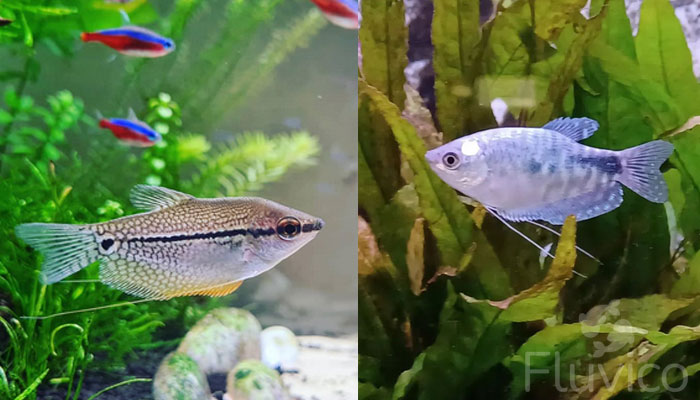
Breeding Gouramis
Selecting a Male and Female
Breeding Gourami’s can be a fascinating process as they are bubble nest builders. However, successful breeding requires careful preparation and close monitoring.
- Selecting a Pair: When selecting a breeding pair of Gourami’s, choose healthy, mature fish. Males are usually more brightly coloured and have a pointed dorsal fin, while females are more rounded, especially when they are full of eggs.
- Conditioning the Breeding Pair: Feed the selected pair a diet rich in live or frozen foods to encourage spawning. High-quality nutrition helps to ensure the health of both parents and the subsequent fry.
- Breeding Tank Setup: Set up a separate breeding tank with shallow water, around 6 to 8 inches deep. The water should be slightly acidic and around 80°F. Include floating plants or a piece of Styrofoam to support the bubble nest.
Breeding Process
- Bubble Nest Building: The male Gourami starts the breeding process by building a bubble nest. This involves blowing bubbles that stick together on the water’s surface, often under a leaf or a piece of floating debris.
- Courtship and Spawning: Once the nest is ready, the male will court the female by swimming around her and flaring his fins. If the female is ready, she’ll approach the male, and they will engage in a spawning embrace under the bubble nest. The male wraps his body around the female, who releases her eggs while he releases milt for fertilization.
- Egg Care: After fertilization, the eggs float up into the bubble nest. The male then guards and maintains the nest, picking up any eggs that fall out and blowing additional bubbles as needed.
- Fry Care: Once the fry hatch, they will stay in the bubble nest, receiving care from the male until they are free-swimming. At this point, it’s crucial to remove the male to prevent him from eating the fry.
Remember, successfully breeding Gourami’s requires providing an environment that closely mimics their natural habitat, including water parameters, temperature, and cover in the form of plants or other materials. The fry will need appropriate care and nutrition to grow and thrive.
Should You Get a Gourami for Your Aquarium?
In conclusion, Gourami’s can be a great addition to your aquarium due to their vibrant colours, intriguing behaviour, and manageable care requirements. They are adaptable, hardy, and can get along with many other species, making them a good choice for both beginners and experienced aquarists.
However, their care involves providing the right environment, diet, and attention to water quality. They may also require a larger tank size as they grow. If you’re ready for the commitment and intrigued by the prospect of potentially breeding these fascinating bubble-nesters, Gourami’s could be an excellent choice for you.
Remember, always research the specific needs of the Gourami species you’re interested in keeping.

FAQ
What Type Of Tank Is Best For Gouramis?
The best tank is a well-filtered, heated aquarium with a capacity suitable for their species size, filled with live plants, hiding spots, and a calm current to mimic their natural environment. The water should be slightly acidic to neutral.
What do Gourami’s Eat?
Gourami’s are omnivorous, consuming a balanced diet of high-quality flake or pellet food, supplemented with live or frozen foods like brine shrimp and bloodworms. They also appreciate occasional vegetables, contributing to a varied diet.
Are Gourami good with other fish?
Yes, Gourami’s generally get along with other peaceful, similarly-sized fish. However, they can be territorial, especially males during breeding. Avoid pairing with aggressive species or much smaller fish that could be stressed or bullied.
How many Gourami’s should be kept together?
The number of Gourami’s kept together depends on tank size and the Gourami species. Generally, keep one male with multiple females to prevent aggression. Ensure each Gourami has enough space and hiding spots to feel secure.
Are Gourami’s hard to take care of?
Gourami’s have moderate care requirements. While they are relatively hardy, they require specific water conditions, a balanced diet, and suitable tank mates. They aren’t particularly challenging for aquarists with a basic understanding of fish care.
Why is my Gourami not swimming around?
Your Gourami might not be swimming around due to illness, stress, poor water conditions, or inadequate diet. Check the tank’s temperature, pH, and ammonia levels, and observe the fish’s appearance and behaviour for signs of disease.
Why is my Gourami staying at the top of the tank?
Your Gourami staying at the top might indicate low oxygen levels in the tank, stress, or illness. Also, Gourami’s are labyrinth fish that breathe air, so occasional surfacing is normal. Ensure water conditions are optimal and observe for other unusual behaviours
How long can Gourami’s survive outside water?
While Gourami’s can breathe air thanks to a unique organ, their survival outside water is limited to a few minutes to an hour, depending on conditions. However, they aren’t meant to be out of water for extended periods. Handle with care and maintain proper aquarium conditions.
More Reading

15 Types of Cryptocoryne: Which is Best For Your Aquarium Setup?

16 Awesome Low Light Aquarium Plants (Mosses, Ferns & Stem Plants)


18 Types of Aquarium Moss: Photos, Care, Propagation & Growth Guide
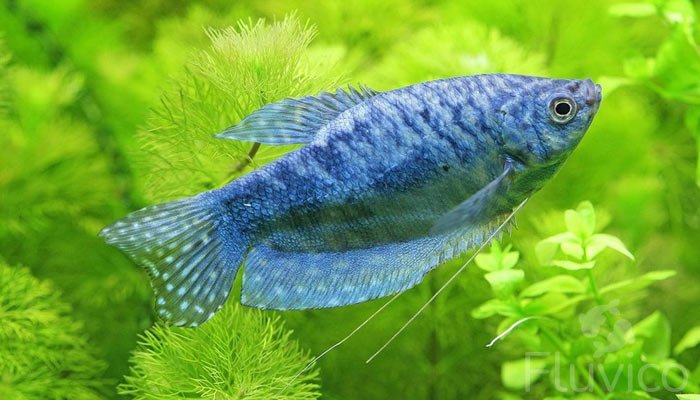
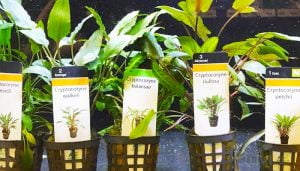
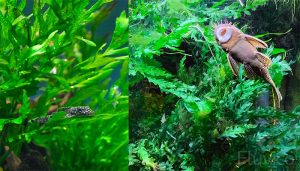


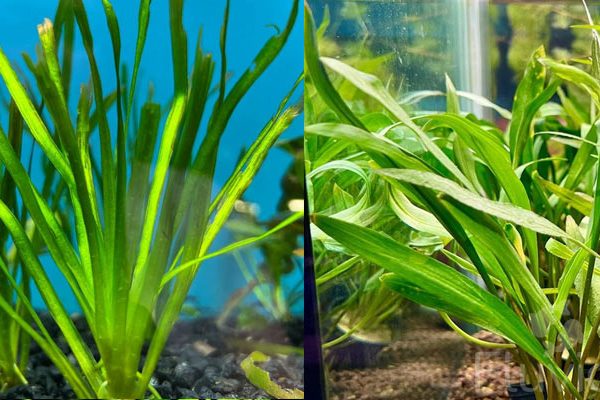

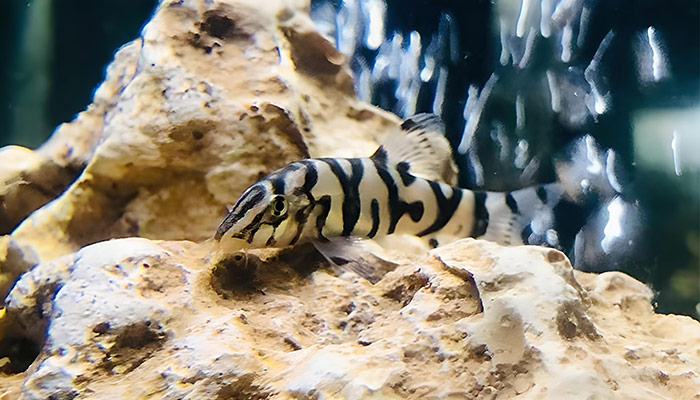
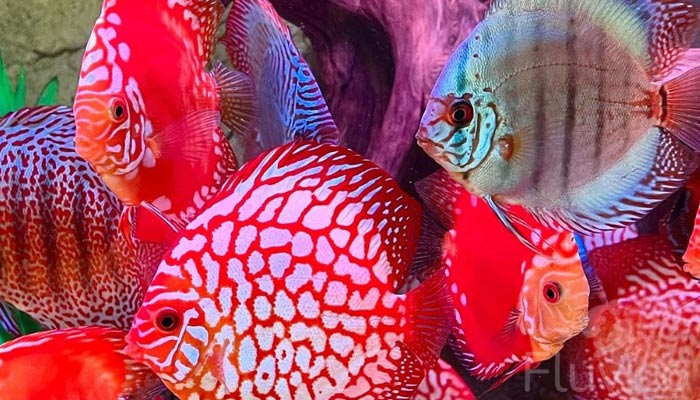

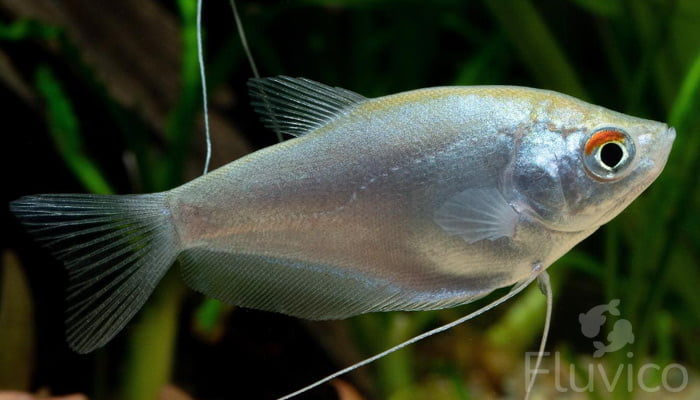
Hope you enjoyed our Gourami Care Guide!
If you have any questions? Ask away, we’re here to help!
All the best,
Daniel